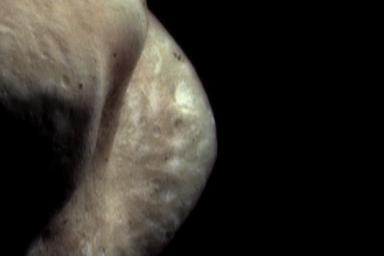
|
Color View of the Saddle
- Click the image above for a larger view
- Full-Res JPEG (468 x 312) (9.9 kB)
- Full-Res TIFF (468 x 312) (212.7 kB)
Caption:
Color imaging of Eros from the NEAR Shoemaker spacecraft has shown the asteroid's color variations are very subdued when compared to those of other planetary bodies, such as Mars. However, both the imager and the near-infrared spectrometer have detected discernible color differences between parts of the asteroid.
One location on Eros with distinctive color is the eastern side of the "saddle." This color composite image of that region was taken April 2, 2000, from an orbital altitude of 201 kilometers (125 miles). In this false color representation, the red and green image planes were taken in different wavelengths of infrared light, and the blue image plane was taken in blue light. NEAR scientists interpret the bright and greenish-gray appearing regions near the rim of the saddle to represent relatively fresh exposures of subsurface soil. In contrast, the pinkish looking soil covering other areas is thought to have been modified by exposure to small impacts and the solar wind.
Background Info:
Built and managed by The Johns Hopkins University Applied Physics Laboratory, Laurel, Maryland, NEAR was the first spacecraft launched in NASA's Discovery Program of low-cost, small-scale planetary missions. See the NEAR web page at http://near.jhuapl.edu/ for more details.
Cataloging Keywords:
| Name | Value | Additional Values |
|---|---|---|
| Target | 433 Eros | |
| System | Near Earth Objects | |
| Target Type | Asteroid | |
| Mission | NEAR Shoemaker | |
| Instrument Host | NEAR Shoemaker | |
| Host Type | Orbiter | |
| Instrument | Multi-Spectral Imager (MSI) | |
| Detector | ||
| Extra Keywords | Color, Impact, Infrared | |
| Acquisition Date | ||
| Release Date | 2000-06-10 | |
| Date in Caption | 2000-04-02 | |
| Image Credit | NASA/JPL/JHUAPL | |
| Source | photojournal.jpl.nasa.gov/catalog/PIA02921 | |
| Identifier | PIA02921 | |
